EDWIN VERGARA is anything but settled in his new restaurant.
He is casually shuffling between tables, keeping watch of newcomers and finished eaters and striking up spontaneous conversations with seated customers who, upon learning who he is, are more than thrilled to have their photo taken with him.
He is doubtless better known by his nickname: Mang Tootz.
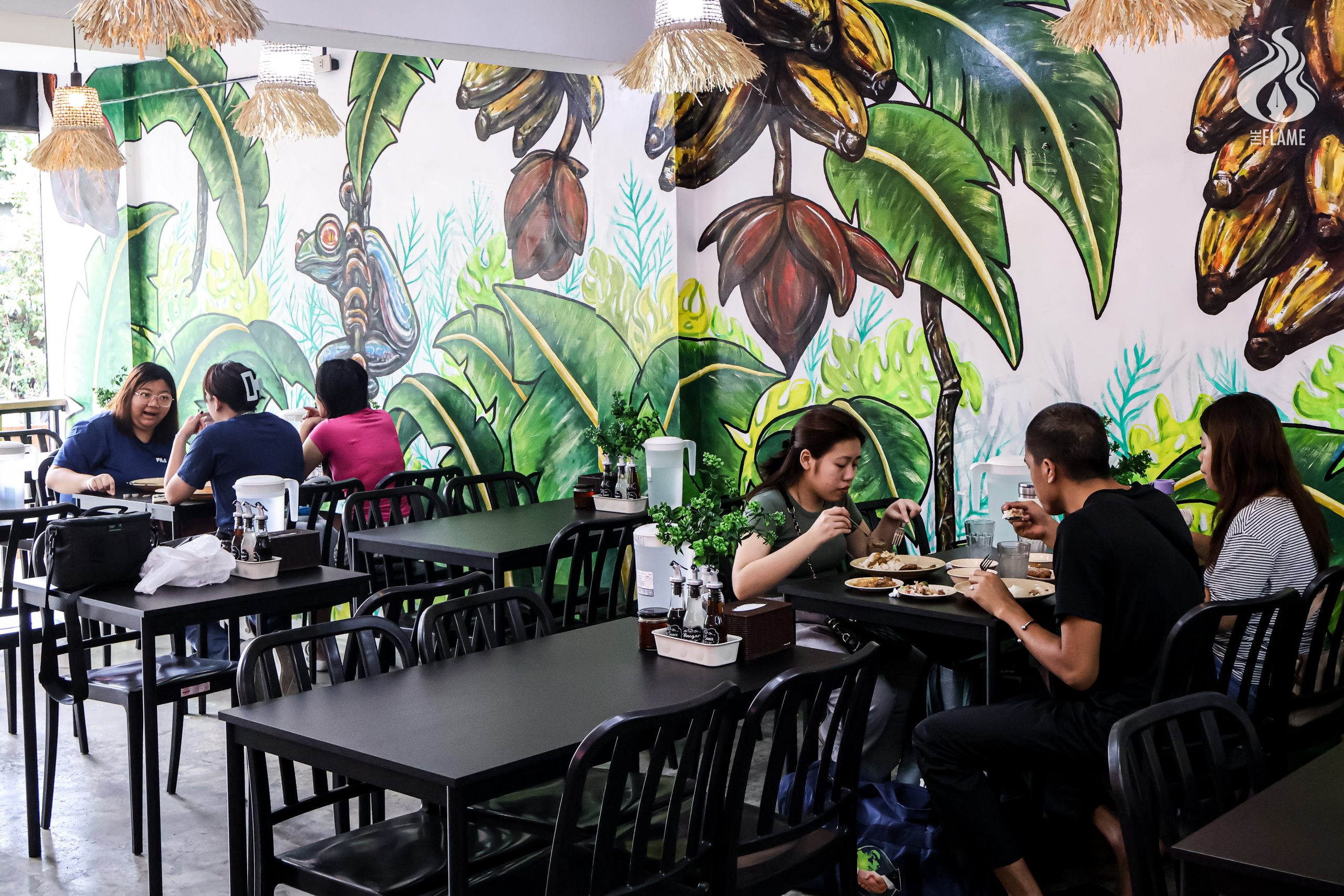
His karinderya (eatery), Mang Tootz Foodhouse, has long been an icon in Padre Noval (P. Noval) Street. Now, it occupies the ground floor of a building where the row of cafés and eateries of Jorge Barlin (J. Barlin) Street ends, just off P. Noval Street, in Sampaloc, Manila.
The new space is considerably larger than the previous one: it is wide enough to hold three rows of tables inside, totaling 14, and it opens to the street outside so that air flows freely. In the old place, one needs to sidle with customers at the narrow entrance to order. Here, one can walk without the fear of bumping into other eaters and shattering condiment bottles.
An awaited relief
This move brings a sigh of relief for Edwin.
“Hindi na kami stressed (We don’t feel stressed out anymore),” he said.
Prior to the pandemic, he and his staff were already worrying about the Manila City Hall’s prohibition of sidewalk vending. For 29 years in their old location, they had gotten used to setting up tables and chairs in front of their karinderya, which occupied the ground floor of a four-story Brutalist tenement.
Jossa Vergara, Edwin’s daughter who manages the karinderya, fondly recalled that on some days, customers teemed that their tents had to spill far onto the other side of the street. Whenever this happened, usually at noon and at night, the crowd of students and employees from the University Belt would be so loud that the staff would have to use megaphones just to hear themselves take orders.
When former Manila Mayor Isko Moreno took office, this bustling scene was wiped away.
“ ‘Yung chairman namin,” Edwin recalled, “tatawag doon sa Department of Public Services, sasabihin ‘Oh, si Mang Tootz, naglatag na naman’ (Our chairman would call the Department of Public Services and say, ‘Mang Tootz set up in the street again’).”
Thereupon, dump trucks would arrive and seize their tables and chairs.
“ ‘Yung mga gamit ko, pa-onti na nang pa-onti! (My things dwindled little by little!),” Edwin said.
“Matagal na naming gustong lumipat. Naghahanap lang talaga kami ng puwestong malapit sa University (We have been wanting to move for the longest time, we were just looking for a place that was near the University).”
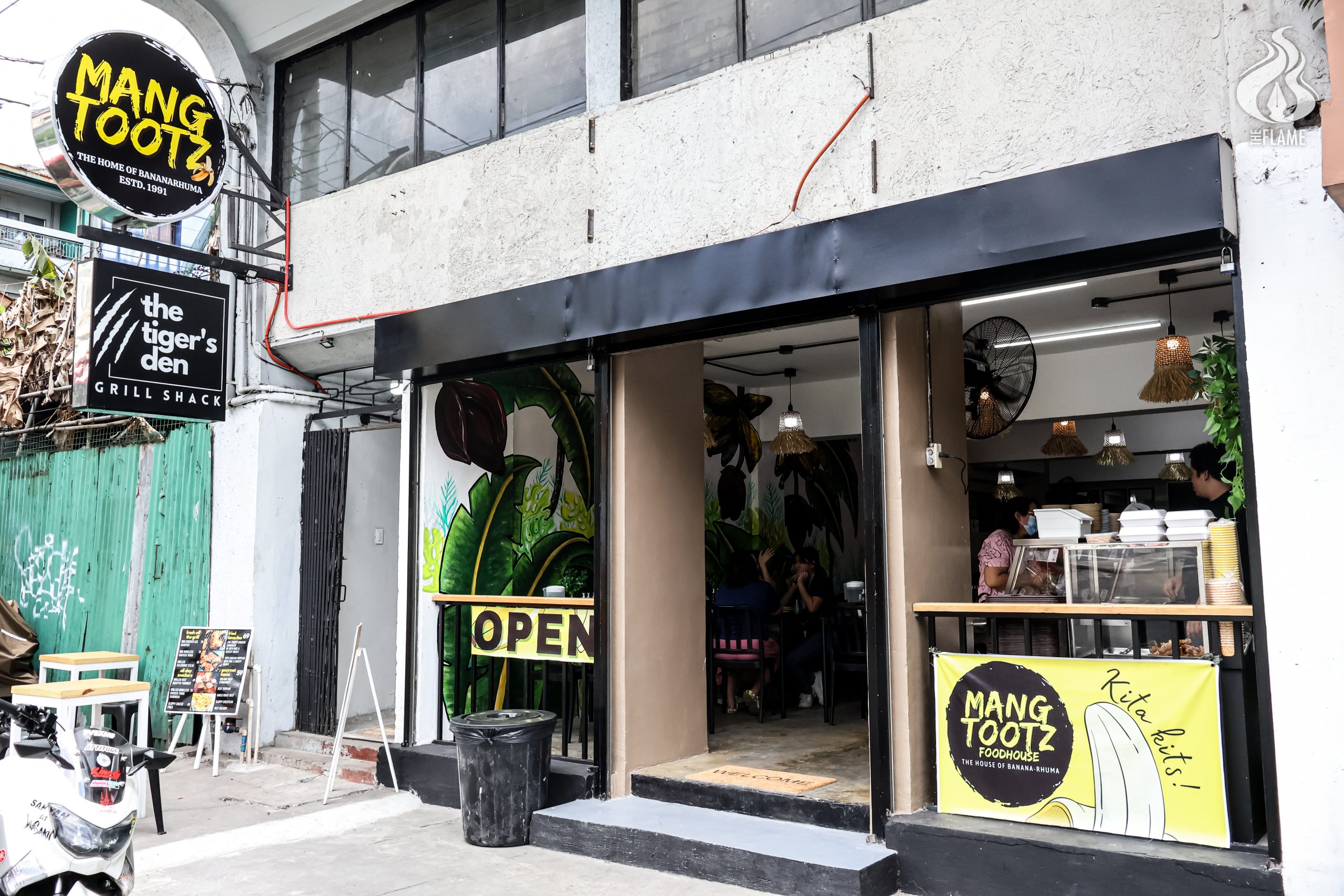
Early this year, a series of fortunate events led them closer in their search: a steakhouse in J. Barlin closed, and the building owner’s daughter-in-law happened to be Jossa’s high-school friend.
Finally, on April 1, Mang Tootz Foodhouse was able to move into its new home. They feel happy there, Edwin says — no more clearing operations and enough room for customers, rain or shine.
A storied corner
Yet Edwin still holds nostalgia for the old location.
“Malungkot,” he said “dahil 29 years na kami doon, sa bahay namin, at tahimik na doon (It’s sad, because we have been there for 29 years, at our home, and it’s quiet there now).”
He consistently referred to the old location as his “home” — because it actually is his home. To this day, he and his family live in a flat directly above the karinderya. His wife’s family owns the building. At night, after a day’s work, all of the things in the karinderya are moved — the long stainless-steel counter, wooden tables, Monoblock chairs — to give way for the Vergaras’ family van.
This was the storied corner where television show hosts, vloggers and countless batches of Thomasians sat down for a meal. But, most important, this was also the place where the banana rhuma, Edwin’s original spin on the turon that became his claim to fame, first appeared on the karinderya counter in 2007.
Surviving the pandemic
A memory Edwin proudly recalled was when, despite all odds, they were able to operate during the pandemic.
In the middle of 2020, when the Inter-Agency Task Force allowed restaurants to open for takeout orders, Edwin was uneasy.
“Sabi ko sa anak ko, ‘Paano tayo magbubukas niyan?’ Sabi ni Jossa, ‘Dad, may Facebook na.’ (I told my daughter, ‘How can we even open?’ Jossa said, ‘Dad, there’s Facebook.’).”
They started announcing their daily menus online, and netizens fired their orders.
Edwin quickly contrived a system: on the third and fourth floors of their building, an onsite staff of six cooked four meals a day and churned thousands of banana rhumas. A single staff member manned a small opening on the ground floor to take orders, give change, and deliver the food all the way from upstairs down to the ground floor.
The system ran initially well, but after a few days, the staff member had already grown pale out of exhaustion. Ever the problem solver, Edwin devised a pulley system. Food was placed on a plastic basket and lowered precariously from a window, creating a scene reminiscent of the rustic villages in Flemish master Pieter Bruegel the Elder’s paintings.
It went well again, but another problem arose: the staff, who had been shouting the orders all day long from the ground floor, was losing his voice. Edwin came up with a final solution: he bought a walkie-talkie.
Edwin’s karinderya survived those two years when virtually all of the food establishments around him were shutting down. For him, diskarte — the Filipino concept of getting through hurdles with grit and resourcefulness — is a virtue.
This, however, was not the first time that Edwin moved out — it was his third.
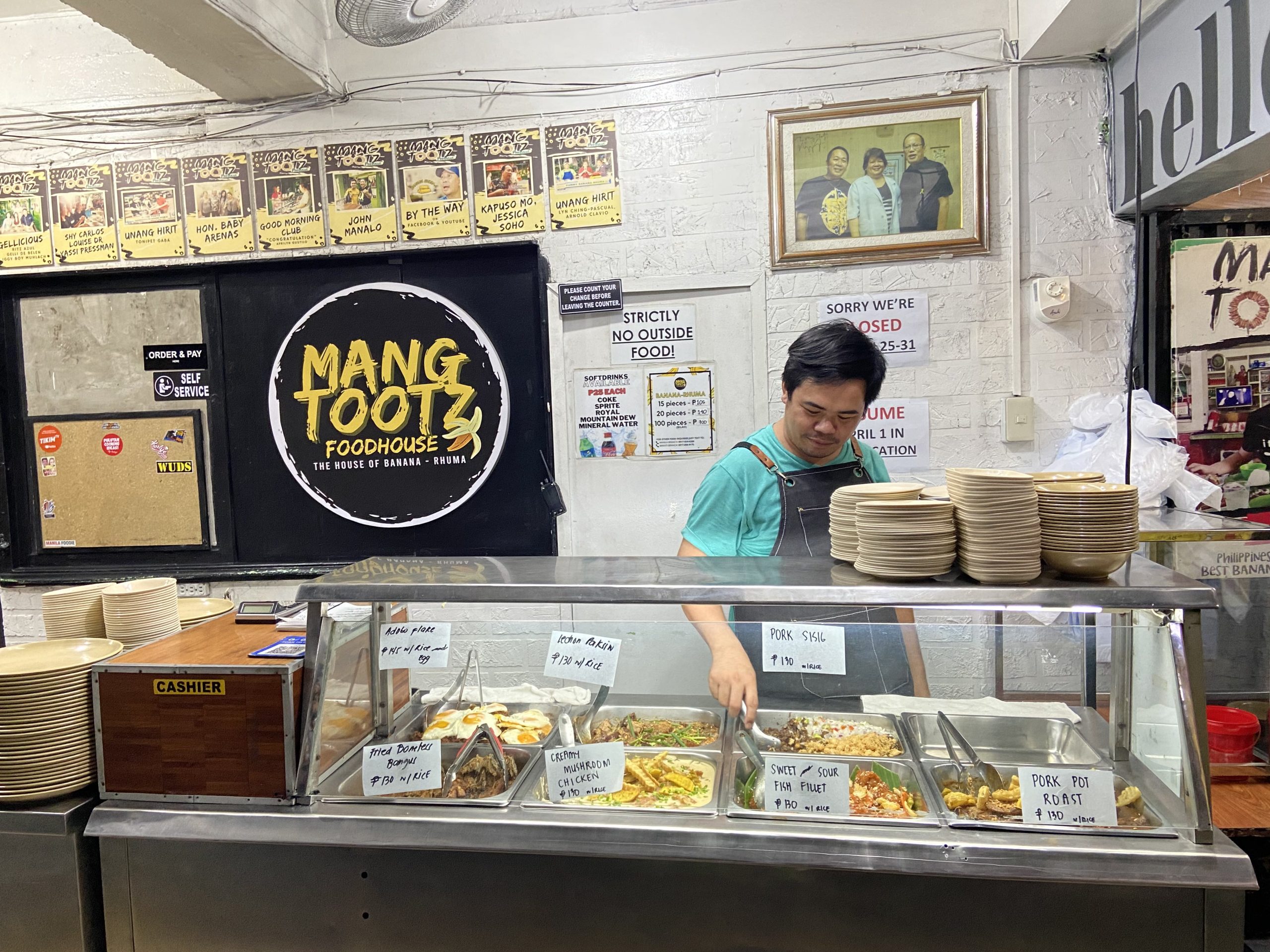
In 1991, he opened his first karinderya called “Tootzchielog” — a portmanteau of his son and wife’s names, Tootz and Luchie, respectively. (The egg, he said, was him). It was a tapsilogan located on the corner of Eloisa Street and J. Barlin Street. Soon enough, he came to be known around the streets as “Mang Tootz.”
Three years later, he moved to a prime location directly across Gate 7 of the University, where the McDonald’s branch on P. Noval Street now stands. The airy space pleased him and his customers. The rent, however, was far from pleasing: P20,000 a month, roughly P50,000 in today’s economy.
In 1995, he moved to the storied location that became Mang Tootz Foodhouse.
“Natikman ng mga customers ko sa UST at iba pang unibersidad ‘yung mga ulam ko, at pumasa naman ako sa panlasa nila (My customers from UST and from other universities tasted my meals, and their tastebuds approved of me),” he said.
“Hanggang sa umabot ako ng 33 years” (Until I reached 33 years).”
A culinary calling
Since his childhood years, Edwin already wanted to have a restaurant of his own. He was born in the sleepy town of Nabua, in Camarines Sur, Bicol. The eldest of five children, he grew up in his grandmother’s house, which stood along the row of old stately houses in the street adjacent to the town church.
He remembered that when it was fiesta season, or when a family member was about to be wedded, the townspeople would go to their house as early as eve to help in the cooking, and he would watch them in action, leaving him in awe.
“Palaging may kinakatay na isa o dalawang baboy, mga manok (Always, a pig or two and chickens will be butchered),” he recounted.
“Kapag nagluluto ng mga embutido, mano-manong tinitira namin ‘yan. Tapos kapag nagkatay kami, may malaki kaming lamesa at may kusinerong nagkakatay. Nandoon ako, nandoon ako (When we cooked embutido, we would cut them by hand. And when we butchered a pig, we had a large table where we would place it, and a butcher would cut it all up. I was there, I was there).”
Eventually, his grandmother let him join in the kitchen.
“Sasabihin ng lola ko, ‘Sige, haluin mo ito, lasahan mo yan, gawin mo ito.’ Hanggang sa lumaki na ako, ako ang palaging alalay ng lola ko sa pagluluto (My grandmother would say, ‘Stir this, taste this, do this.’ Until I grew up, and I was always my grandmother’s helper in cooking).”
“Natuto ako doon” (I learned from there).
A persevering spirit
When he was 12, he moved to Manila and studied at the Far Eastern University Boys’ High School. In college, he took up Accounting at the same university. He said he did not want to follow his father and uncle’s suit, who were both veterans of the Philippine Navy. Eventually, though, he switched to Nautical in his second year.
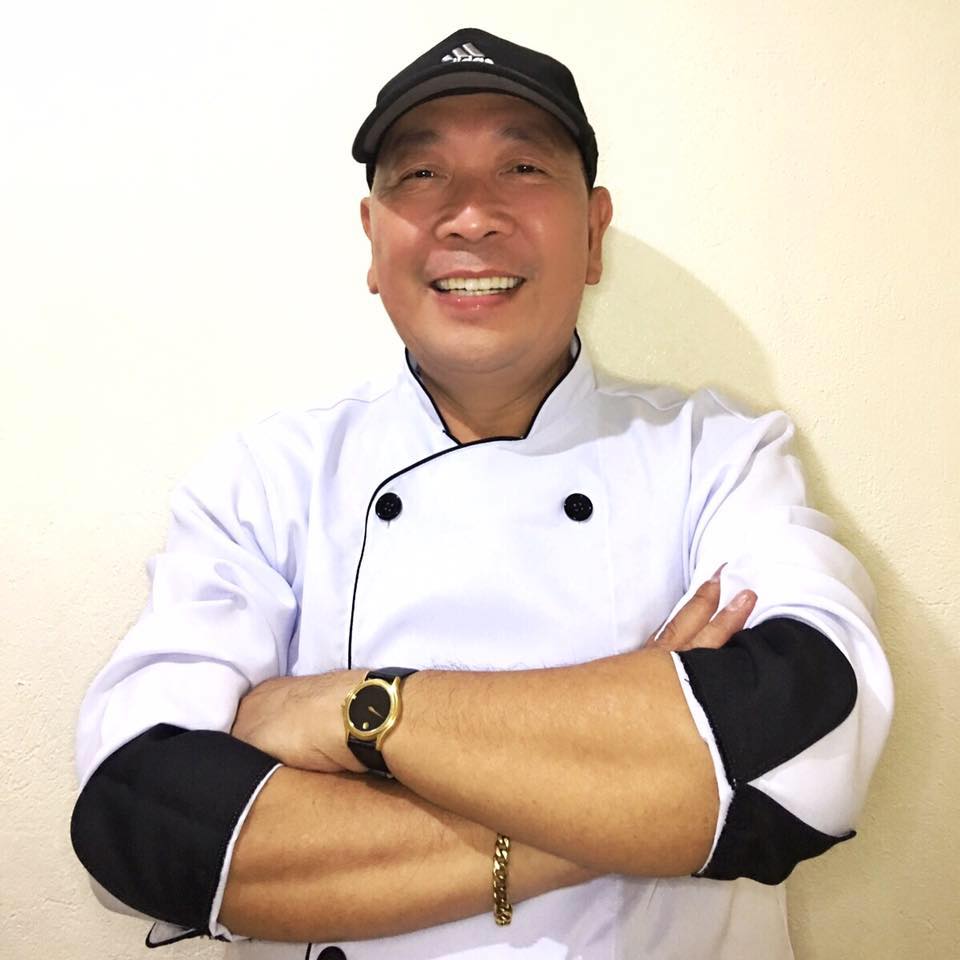
Embodying diskarte, Edwin started working in 1978 while he was still studying. He bartended for four years at the newly opened Silahis International Hotel on Roxas Boulevard, at the exclusive Playboy Club of Manila.
In 1981, Mang Tootz and his colleagues joined the huge wave of overseas Filipino workers, landing jobs in the Middle East. He entered the staff of a five-star hotel in Saudi Arabia as a server, and, in two months’ time, was already their maître d’hôtel.
One day, two years into his tenure, he asked the hotel management to transfer him to the kitchen section.
“Gusto ko naman matuto magluto sa kusina kasi mayroon talaga akong pangarap na magtayo ng —” he paused for a moment, and continued slowly, “karinderya, food house, at parang restaurant na rin (I wanted to learn the ropes in the kitchen, because I have a dream to establish a karinderya, food house, and a restaurant of sorts).
“Nahasa ako nang nahasa sa kusina (I was honed in the kitchen),” he said of his experience in the hotel kitchen.
He eventually returned to the Philippines, returning to bartending on a luxury cruise ship. But after two more years, with his wife, his two young children, and a culinary dream waiting for him in the Philippines, he decided to stay in the Philippines for good. Thus, his career in the food business began.
An innovative mind
Today, Edwin is satisfied with the fact that his two children were able to finish their studies through the karinderya.
“Ngayon, family business na ito,” he said.
At present, his eldest son, Tootz Junior, now manages their Makati branch at Salcedo Village. His daughter, Jossa Vergara, who finished her studies in Dentistry, manages their branch in Manila together with her fiancé. Back in his Bicol hometown, a branch thrives under the care of his sister. Edwin said he plans to retire there with his wife.
Still, Edwin’s passion for cooking would strike one as insatiable. At 66 years old, he still wants to improve his skills. The fare of his karinedrya has always reflected this: it notably has its mainstay kebabs, bulgogi, and fish fillet with tartar sauce; more recently, fish fillet coated in gochujang sauce was added. He still likes to tune in to the Asian Food Channel and watch cooking videos on YouTube, in search of new dishes and methods to learn.
“Gusto ko, kinabukasan, niluluto ko na agad! (I want to try cooking them the next day!),” he said.
“Kapag namamalengke ako,” he continued, “kapag nakikita ko ang isang gulay o karne, umiikot na ang imahinasyon ko. Excited ako palagi magluto ng bagong putahe (Whenever I go to the market and see a vegetable or meat, my imagination runs wild. I am always excited to cook new dishes).”
Redefining the karinderya has always been his goal.
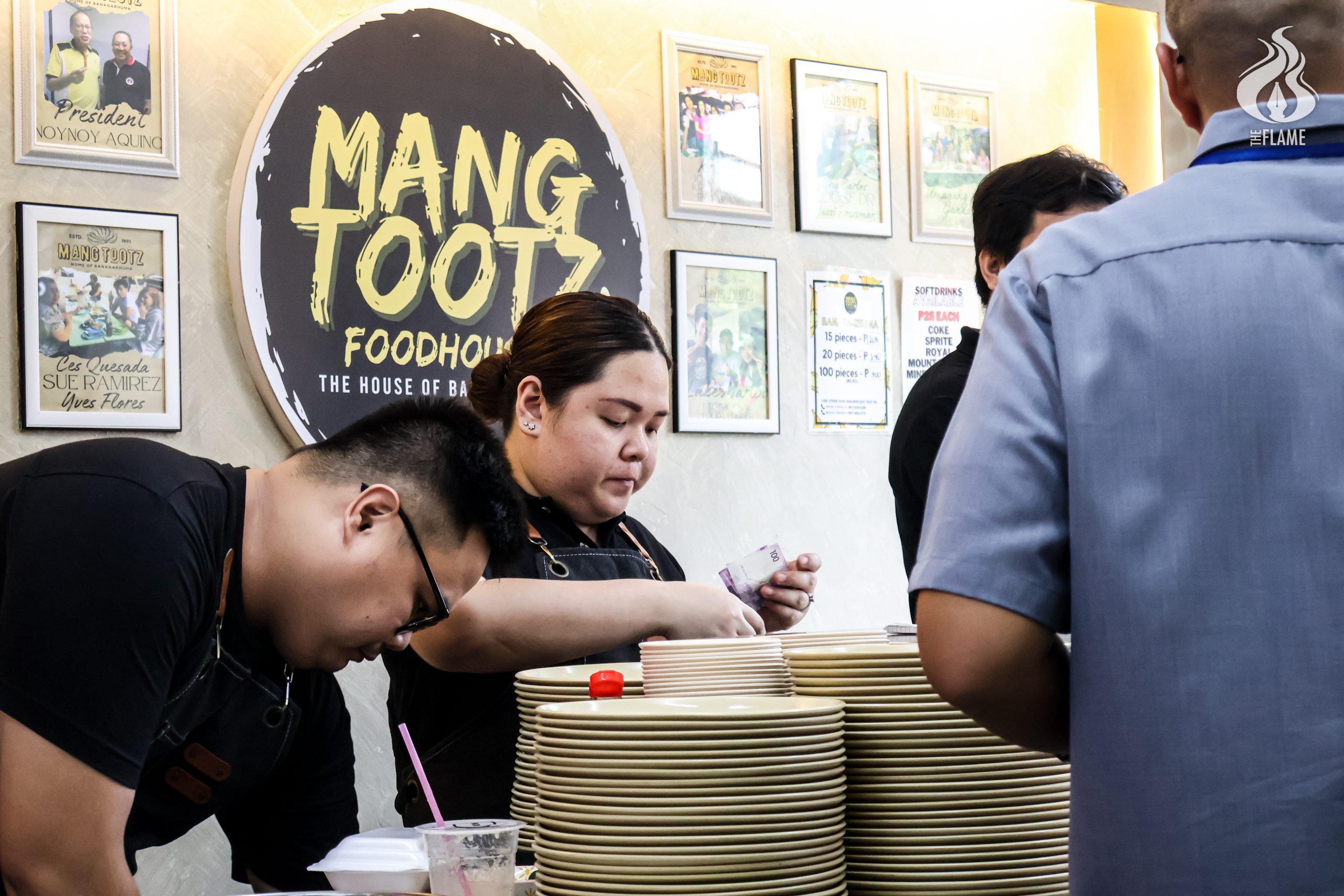
“Ang gusto ng anak ko, si Jossa, magkaroon ng malaking restaurant (What my daughter Jossa wants is to have a large restaurant),” Edwin said.
“Yun ang dream niya. Pero ang sabi ko, ito, malaki na ‘to. So, magkoncentrate muna tayo dito (That is her dream. But I said this is already big. Let us concentrate here for now).”
Mang Tootz still calls it a karinderya, because customers still point to the dishes displayed at their counter.
“Sabi ko nga, siguro tayo na ang pinakamagandang karinderya sa Maynila (I said, we may be the most beautiful eatery in Manila).”
A legacy served
Indeed, the ambiance of the new place has been significantly upgraded, and one may already consider it a restaurant in its strict definition. There is none of the grimy, jammed feeling of the old location — a fact that gives one relief and nostalgia all at once.
Yet one still feels the charm of its old home. It has not become a spick-and-span place that has lost all of its identity. It has only made his lifework even more visible.
As one enters the place, one sees a mural on the left, depicting branches of banana tree stems that stretch across the whole wall and teem with Saba bananas. A strong, saccharine smell catches one’s attention, and as one looks to the right, one sees a veritable mountain of little turon piled on a tray, bedecked with sesame seeds and powdered sugar. Under the light fixture, they gleam like amber struck by sunlight.
The banana rhuma, a source of great satisfaction for Edwin, is perhaps the best embodiment of his life.
“Alam mo, ang dream ko noong nasa Saudi Arabia ako, makagawa ako ng sauce na makikilala sa mundo (You know, when I was still in Saudi Arabia, my was to make a sauce that would be known across the world),” he said.
“Ito, bigla na lang pumitik sa akin, ‘yung banana rhuma sauce, dahil pinagsama ko ang bartending at culinary experience ko (The idea of the banana rhuma sauce came to me in a snap, because I combined my bartending and culinary experiences).”
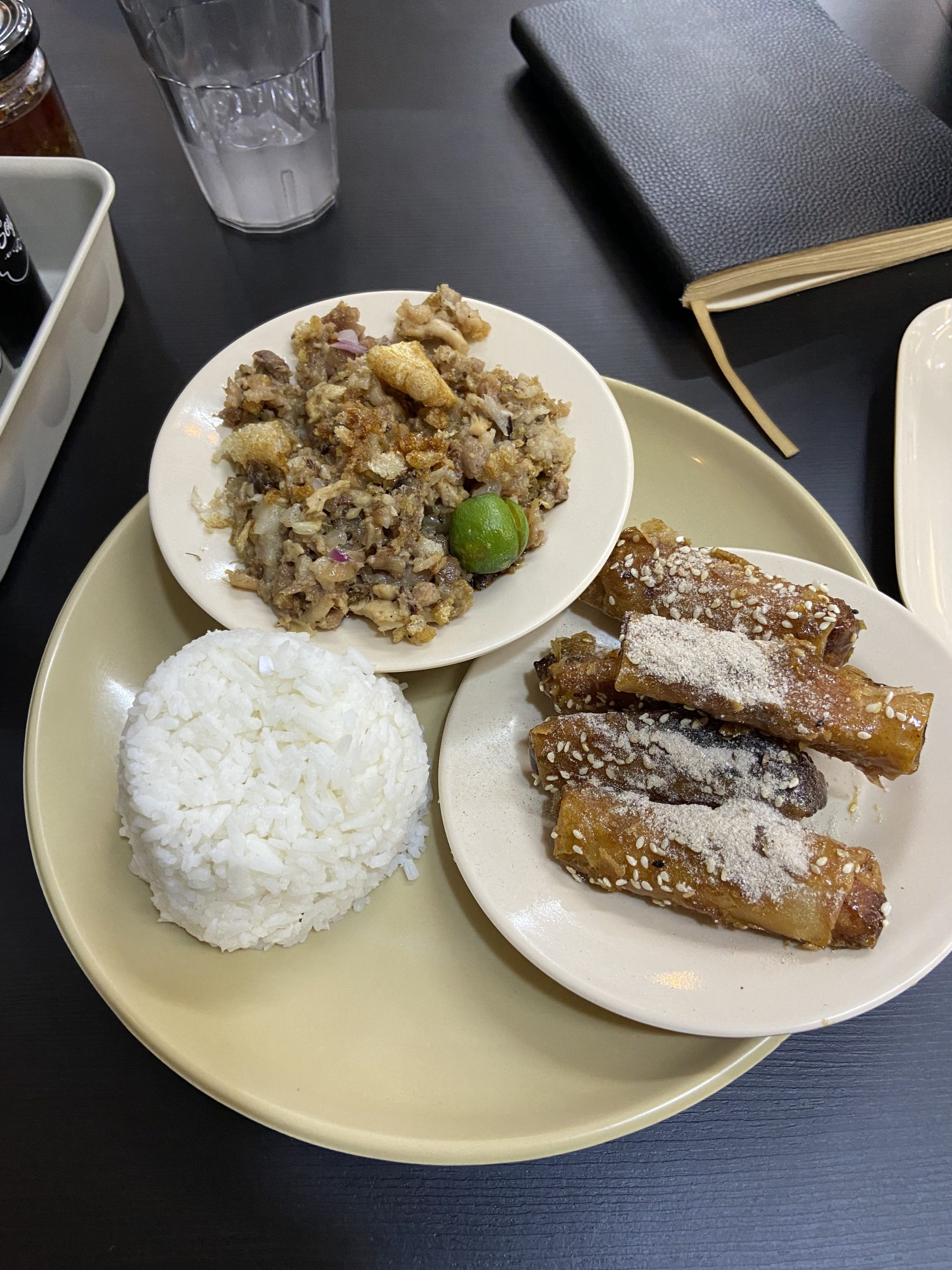
The sauce is a concoction of butter, brown sugar, pineapple juice, banana essence, banana-flavored syrup, jackfruit and cinnamon, which he caramelizes until it reaches a consistency enough to stick to the bite-sized turon — he got that from his culinary experience. But then the sauce is cleverly spiked with a splash of Tanduay rhum – he got that from his bartending experience.
The idea, he said, came from his days in his grandmother’s house, when he was helping his lola coat hundreds of pili nuts in caramel. He fussed over the recipe for three months until he thought it was good enough. Today, his karinderya churns out 10,000 pieces of turon every day.
He then launched into singing the words “ba-nana, rhum-a” to the tune of “Kokomo,” a song by The Beach Boys that hit in the late 1980s and was, according to him, where he got the name for his creation, in one moment of epiphany. His mind may have filled in the blanks: not once do the words “banana” and “rhuma” come up in the song.
Indeed, Edwin is an icon for different generations of Thomasians who would turn nostalgic when talking about their dining experiences at his roadside eatery. Some would even joke that one cannot claim to be a Thomasian if he or she has not tried his banana rhuma.
While Edwin has gone a long way, he still considers himself a typical karinderya owner who ensures that his patrons are happy from the moment they enter his restaurant until they finish their meal.
“Balik po kayo (Come again)!” Mang Tootz shouted as a group of three exited his place. F



